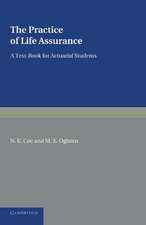A First Course in Quantitative Finance
Autor Thomas Mazzonien Limba Engleză Hardback – 28 mar 2018
| Toate formatele și edițiile | Preț | Express |
|---|---|---|
| Paperback (1) | 465.27 lei 6-8 săpt. | +95.14 lei 7-11 zile |
| Cambridge University Press – 21 mar 2018 | 465.27 lei 6-8 săpt. | +95.14 lei 7-11 zile |
| Hardback (1) | 889.07 lei 6-8 săpt. | |
| Cambridge University Press – 28 mar 2018 | 889.07 lei 6-8 săpt. |
Preț: 889.07 lei
Preț vechi: 1033.80 lei
-14% Nou
Puncte Express: 1334
Preț estimativ în valută:
170.15€ • 175.77$ • 141.60£
170.15€ • 175.77$ • 141.60£
Carte tipărită la comandă
Livrare economică 25 martie-08 aprilie
Preluare comenzi: 021 569.72.76
Specificații
ISBN-13: 9781108419574
ISBN-10: 1108419577
Pagini: 598
Ilustrații: 141 b/w illus. 34 tables
Dimensiuni: 179 x 254 x 30 mm
Greutate: 1.33 kg
Editura: Cambridge University Press
Colecția Cambridge University Press
Locul publicării:Cambridge, United Kingdom
ISBN-10: 1108419577
Pagini: 598
Ilustrații: 141 b/w illus. 34 tables
Dimensiuni: 179 x 254 x 30 mm
Greutate: 1.33 kg
Editura: Cambridge University Press
Colecția Cambridge University Press
Locul publicării:Cambridge, United Kingdom
Cuprins
1. Introduction; Part I. Technical Basics: 2. A primer on probability; 3. Vector spaces; 4. Utility theory; Part II. Financial Markets and Portfolio Theory: 5. Architecture of financial markets; 6. Modern portfolio theory; 7. CAPM and APT; 8. Portfolio performance and management; 9. Financial economics; 10. Behavioral finance; Part III. Derivatives: 11. Forwards, futures and options; 12. The binomial model; 13. The Black–Scholes theory; 14. Exotics in the Black–Scholes model; 15. Deterministic volatility; 16. Stochastic volatility; 17. Processes with jumps; Part IV. The Fixed-Income World: 18. Basic fixed-income instruments; 19. Plain vanilla fixed-income derivatives; 20. Term structure models; 21. The LIBOR market model; Appendix A. Complex analysis; Appendix B. Solutions to problems.
Recenzii
'A First Course in Quantitative Finance is a gentle introduction in a complicated subject. It covers most important topics - such as portfolio optimisation, derivative pricing, and fixed income products - and discusses them from the perspective of financial economics and financial mathematics. It provides the necessary mathematical background, contains the financial discussion, and is full of illustrative examples. It will be useful for anyone who wants to study the subject area on an advanced level.' Rüdiger Kiesel, Universität Duisburg-Essen
'This is a remarkably complete book on all aspects of modern finance, covering topics from the puzzles of financial economics, through modern portfolio management to the pricing of exotic options under stochastic volatility at an equally accessible yet state-of-the-art level. Quants, portfolio managers, students and teachers of finance alike will find it to be an invaluable source of insights and a must-have reference to have on their desks.' Peter Tankov, École nationale de la statistique et de l'administration économique
'This is a remarkably complete book on all aspects of modern finance, covering topics from the puzzles of financial economics, through modern portfolio management to the pricing of exotic options under stochastic volatility at an equally accessible yet state-of-the-art level. Quants, portfolio managers, students and teachers of finance alike will find it to be an invaluable source of insights and a must-have reference to have on their desks.' Peter Tankov, École nationale de la statistique et de l'administration économique
Notă biografică
Descriere
Using stereoscopic images and other novel pedagogical features, this book offers a comprehensive introduction to quantitative finance.








